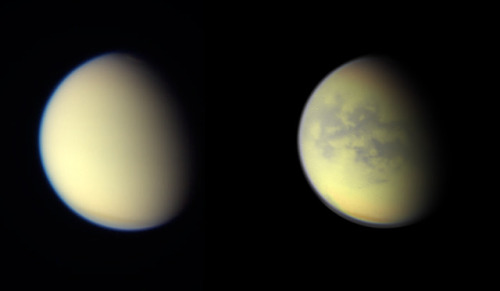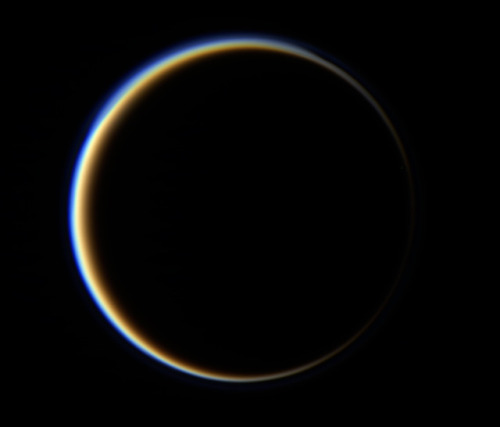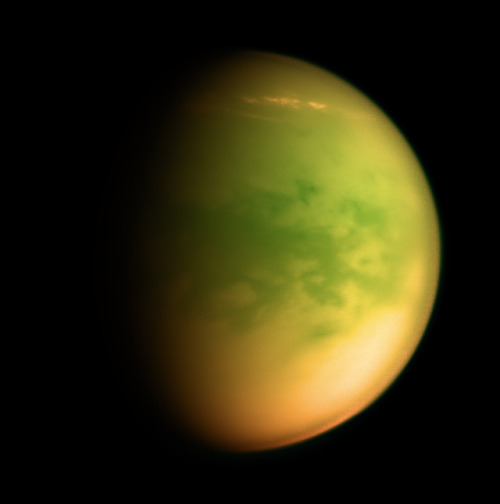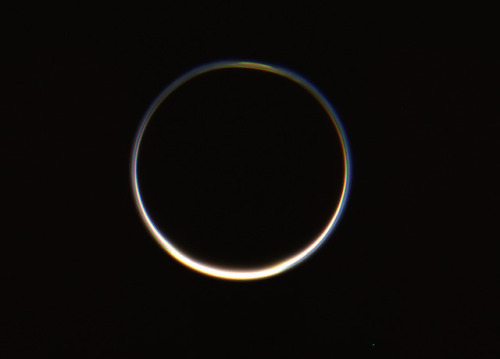Lunar Rings
Lunar Rings


Pictures of the Day - October 21, 2018
Normally, giant planets are the ones with rings, but in some situations a moon of a gas giant can have its own rings. Here we come across such a satellite.
More Posts from Sharkspaceengine and Others
Ultra-Close Orbits of Saturn = Ultra-Cool Science
On Sept. 15, 2017, our Cassini spacecraft ended its epic exploration of Saturn with a planned dive into the planet’s atmosphere–sending back new science to the very last second. The spacecraft is gone, but the science continues!

New research emerging from the final orbits represents a huge leap forward in our understanding of the Saturn system – especially the mysterious, never-before-explored region between the planet and its rings. Some preconceived ideas are turning out to be wrong while new questions are being raised. How did they form? What holds them in place? What are they made of?

Six teams of researchers are publishing their work Oct. 5 in the journal Science, based on findings from Cassini’s Grand Finale. That’s when, as the spacecraft was running out of fuel, the mission team steered Cassini spectacularly close to Saturn in 22 orbits before deliberately vaporizing it in a final plunge into the atmosphere in September 2017.

Knowing Cassini’s days were numbered, its mission team went for gold. The spacecraft flew where it was never designed to fly. For the first time, it probed Saturn’s magnetized environment, flew through icy, rocky ring particles and sniffed the atmosphere in the 1,200-mile-wide (2,000-kilometer-wide) gap between the rings and the cloud tops. Not only did the engineering push the spacecraft to its limits, the new findings illustrate how powerful and agile the instruments were.
Many more Grand Finale science results are to come, but today’s highlights include:
Complex organic compounds embedded in water nanograins rain down from Saturn’s rings into its upper atmosphere. Scientists saw water and silicates, but they were surprised to see also methane, ammonia, carbon monoxide, nitrogen and carbon dioxide. The composition of organics is different from that found on moon Enceladus – and also different from those on moon Titan, meaning there are at least three distinct reservoirs of organic molecules in the Saturn system.

For the first time, Cassini saw up close how rings interact with the planet and observed inner-ring particles and gases falling directly into the atmosphere. Some particles take on electric charges and spiral along magnetic-field lines, falling into Saturn at higher latitudes – a phenomenon known as “ring rain.” But scientists were surprised to see that others are dragged quickly into Saturn at the equator. And it’s all falling out of the rings faster than scientists thought – as much as 10,000 kg of material per second.

Scientists were surprised to see what the material looks like in the gap between the rings and Saturn’s atmosphere. They knew that the particles throughout the rings ranged from large to small. They thought material in the gap would look the same. But the sampling showed mostly tiny, nanograin- and micron-sized particles, like smoke, telling us that some yet-unknown process is grinding up particles. What could it be? Future research into the final bits of data sent by Cassini may hold the answer.

Saturn and its rings are even more interconnected than scientists thought. Cassini revealed a previously unknown electric current system that connects the rings to the top of Saturn’s atmosphere.

Scientists discovered a new radiation belt around Saturn, close to the planet and composed of energetic particles. They found that while the belt actually intersects with the innermost ring, the ring is so tenuous that it doesn’t block the belt from forming.

Unlike every other planet with a magnetic field in our Solar System, Saturn’s magnetic field is almost completely aligned with its spin axis. Think of the planet and the magnetic field as completely separate things that are both spinning. Both have the same center point, but they each have their own axis about which they spin. But for Saturn the two axes are essentially the same – no other planet does that, and we did not think it was even possible for this to happen. This new data shows a magnetic-field tilt of less than 0.0095 degrees. (Earth’s magnetic field is tilted 11 degrees from its spin axis.) According to everything scientists know about how planetary magnetic fields are generated, Saturn should not have one. It’s a mystery physicists will be working to solve.

Cassini flew above Saturn’s magnetic poles, directly sampling regions where radio emissions are generated. The findings more than doubled the number of reported crossings of radio sources from the planet, one of the few non-terrestrial locations where scientists have been able to study a mechanism believed to operate throughout the universe. How are these signals generated? That’s still a mystery researchers are looking to uncover.
For the Cassini mission, the science rolling out from Grand Finale orbits confirms that the calculated risk of diving into the gap – skimming the upper atmosphere and skirting the edge of the inner rings – was worthwhile.

Almost everything going on in that region turned out to be a surprise, which was the importance of going there, to explore a place we’d never been before. And the expedition really paid off!
Analysis of Cassini data from the spacecraft’s instruments will be ongoing for years to come, helping to paint a clearer picture of Saturn.
To read the papers published in Science, visit: URL to papers
To learn more about the ground-breaking Cassini mission and its 13 years at Saturn, visit: https://www.nasa.gov/mission_pages/cassini/main/index.html
Make sure to follow us on Tumblr for your regular dose of space: http://nasa.tumblr.com.

Picture of the Day - February 5, 2019 - (Very late post)
I've decided to travel back home in Space Engine.
Earth and the Moon.





Picture of the day - December 26, 2018
Insight A System - Ninth Planet (Insight A-IX)
Insight A-IX is the Insight A systems second largest and second most massive planet. It is an ice giant 17.40 times more massive than Earth, and has a radius of 3.28 Earth Radii. The planet is surrounded by a narrow yet well structured ring system, and a system of 6 small ellipsoidal satellites.
The planet orbits it’s sun at an average distance of 7.34 AU, completing 1 orbit every 18.35 Years. A day on the planet lasts just 9 hours and 6 minutes. The planet has a thick hydrogen/ helium atmosphere, and has an average atmospheric temperature of -279 F.
High Resolution Pictures
Insight A-IX
Small moon
Narrow Rings
Ring Closeup
Crescent
Gas Giant Classification System
Note: this is a modified version of the Sudarsky Gas Giant Classification System, which is a system proposed by David Sudarsky to classify gas giant planets, such as Jupiter and Saturn.
The system that Sudarsky created classifies gas giant planets based off of the temperature of the planet’s atmosphere’s at 1 bar pressure, and the primary chemical that comprises the planet’s cloud decks. His original system contained 5 different types of gas giants: Ammonia, Water, Cloudless, Alkali Metal, and Silicate Clouds)
I have decided to amend his original classification system to include three additional types of gas planets (Nitrogen-Oxygen, Methane, and Carbon), and I believe this system should apply generally to ice giants as well. These modifications cover more types of gaseous planets under a greater range of temperatures and compositions. Again credit to the original idea is given to David Sudarsky.
Type Ib: Nitrogen-Oxygen Class Gas/ Ice Giant

Nitrogen-Oxygen Gas/Ice Giants are the coldest types of gaseous planet. They have atmospheric temperatures of less than 40 K, (-388 °F) at 1 bar pressure. These planets have atmospheric temperatures low enough that oxygen and nitrogen condense into liquid droplets and ice crystals, and at lower depths in the atmosphere it rains liquid nitrogen and oxygen. In hydrogen depleted gas/ ice giants, the cloud decks may even be composed of crystals and droplets of carbon monoxide.
These planets have a primarily deep blue color, with dull gray/blue cloud bands. The blue color of the atmosphere is due to the presence of liquid nitrogen and oxygen lower in the atmosphere which scatters blue light. Gaseous planets of this class planets are relatively rare. Gas giants of this class only exist if they are extremely old (8+ Billion years) and orbit far from their parent star. Most gas giants emit enough internal heat to be too warm to fit this class, given the age of the universe. Ice giants of this class would be more common due to their smaller size and smaller reservoirs of internal heat. Rogue ice giants occupy most planets of this class.
Type Ia: Methane Class Gas/Ice Giant

Methane Class Gas/Ice Giants occupy a temperature range between 40 K and 90 K (-388 °F and -298 °F). These planet’s have atmospheric temperatures that support the formation of methane clouds. Methane is the primary light scattering chemical which gives the planet a deep blue to cyan color. Examples of this class include both Neptune and Uranus.
Methane Class gas planets orbit far from their parent stars, and often emit as much heat as they receive from the sun. Atmospheric activity is driven almost entirely by internally released heat. Planet’s with less heat often appear bland and almost featureless (i.e. Uranus), while planets that emit significant internal heat, show more pronounced cloud bands and even large cyclonic systems (i.e. Neptune). The hue of the planet is believed to be determined by how much methane is in the atmosphere.
Type I: Ammonia Class Gas/Ice Giant (Original Sudarsky Type I)

Ammonia Class Gas/Ice Giants occupy a temperature range between 90 K and 160 K (-298 °F and -172 °F). These planet’s have atmospheres dominated by ammonia ice crystals. Ammonia is the primary light scattering compound that often gives these planets a brownish hue. Temperatures are warm enough in the atmosphere for complex chemistry to occur, including for formation of tholins and other complex hydrocarbons, along with various other chemical compounds dredged up through convection from the interior. Cloud bands may take on numerous colors including: brown, white, red, orange and yellow.
Ammonia Gas giants include both the planets Jupiter and Saturn. The atmosphere of an ammonia gas planet is extremely turbulent and active due to the increased solar radiation. These planets typically orbit just beyond a star systems frost line (the temperature at which ice will not sublimate in a vacuum), but not far enough for methane clouds form.
Type II: Water Class Gas/Ice Giant (Original Sudarsky Type II)

Water Class Gas/Ice Giants occupy a temperature range between 160 K and 250 K (-172 °F and -10 °F). These planets have atmospheres dominated by water-ice crystals, and their atmosphere experiences liquid water rain at lower depths. If a gaseous planet were to support aerial life, Type II planets would be the perfect candidate. Water-Ice reflects a lot of the sunlight making these planets extremely bright with high reflective albedos.
No Water Class Gas or Ice giants exist within the solar system, but examples include: Upsilon Andromedae D or PH2B. Type II planets orbit from the middle of the habitable zone out to the edge of the frost line. Type II gaseous planets orbiting within a system’s habitable zone may have large Earth-like satellites in orbit that are capable of supporting life.
Type IIa: Sulfur Class Gas/Ice Giant

Sulfur Class Gas/Ice Giants occupy a temperature range between 250 K and 350 K (-10 °F and 170 °F). These planets have atmospheres dominated by hydrogen sulfide and sulfur. Cloud decks are composed of crystals of hydrogen sulfide and sulfur-dust. These planets have complex upper atmospheric chemistry dominated by sulfur bearing compounds, and have a composition similar to the clouds of Venus. Atomic sulfur dust in the atmosphere gives the planet’s a distinct yellow hue, and is the result of ultraviolet radiation breaking down hydrogen sulfide though a process called photodissociation.
Sulfur Class Gas/Ice Giants orbit between the center of a system’s habitable zone and a system’s Venus Zone. The atmosphere’s of Type IIa planets are extremely active which cyclonic systems, sharp cloud bands, and chaotic polar regions. As with Type II Gas/Ice Giants, Type IIa planets orbiting within a system’s habitable zone may support Earth-like moons in orbit.
Type III: Cloudless Glass Gas/Ice Giant (Original Sudarsky Type III)

Cloudless Class Gas/Ice Giants occupy a temperature range between 350 K and 800 K (170 °F and 980 °F). These planets have atmospheres that do not lie within a temperature range of any common compounds to exist as either ice crystals of liquid droplets. Methane deep in the atmosphere give the planets a blueish green hue from the scattering of blue light. Due to the lack of clouds, the banding is faint and muted in appearance. Varying concentrations of sulfides and chlorides between the individual weather zones give each band a slightly different hue. If high concentrations of sulfur are present, these planets may take on a violet or purple color from the formation of diatomic sulfur molecules.
Cloudless Class Gas/Ice Giants orbit between roughly a mercury equivalent orbit and the inner edge of the Venus Zone. The atmosphere despite it’s faded appearance, experiences powerful winds and extremely stormy weather. Roughly half of these type of planets orbit close enough to their parent stars to be tidally locked.
Type IV: Alkali Metal Class Gas/Ice Giant (Original Sudarsky Type IV)

Alkali Metal Class Gas/Ice Giants occupy a temperature range between 800 K and 1,400 K (980 °F and 2,060 °F). At these temperatures carbon monoxide becomes the dominate carbon-carrying molecule instead of methane. Metals such as sodium and potassium become more common in the atmosphere, condensing into cloud decks. Additionally clouds containing titanium dioxide and vanadium oxide may also form. Type IV planets typically have a monochromatic color, but some may have hues of dark green or dark red, depending on the composition of the clouds. Most have a very low reflective albedo, reflecting less than 5% of the sunlight they receive.
Alkali Metal Class Gas/Ice Giants orbit close to their parent stars, and most are tidally locked to their sun. Extremely violent weather occurs within the atmosphere, and most experience wind speeds of over 1,000 mph. The increased heat also increases the overall diameter of the planet; therefore, Type IV planets are often larger than Types Ib - Type III of the same mass.
Type V: Ferro-Silicate Class Gas/Ice Giant (Original Sudarsky Type V)

Ferro-Sillicate Class Gas/Ice Giants occupy a temperature range between 1,400 K and 2,800 K (2,060 °F and 4,580 °F). These planets are viewed of as the traditional examples of either a Hot Jupiter or Hot Neptune. Temperatures are hot enough that cloud decks of silicates and iron form in the upper atmosphere. It is not uncommon for molten iron and molten glass rain to occur within the atmosphere. The color of these planets varies wildly depending on whether silicates or iron are more common. Type V planets with silicates dominating the cloud decks will appear bright azure blue in color from liquid droplets of glass scattering blue light. Type V planets where iron dominates the cloud decks will have a more gray-red color. The atmosphere is so hot that it glows a dull red.
Ferro-Silicate Gas/Ice Giants orbit very close to their parent stars with orbital periods of a few days or less and are tidally locked to the sun. Their diameters are puffed up by the intense solar radiation, and the planets often have unusually low average densities, lower than that of even Saturn. Weather is wild in the atmosphere, with winds blowing in excess of 2,000 mph. The winds are so fast and transport heat so efficiently that the night side is almost as hot as the day side despite being in perpetual darkness. A prime example of this planet type would be 51 Pegasi B. (Note this was the first type of planet discovered orbiting a sun-like star outside of our solar system). Due to the close proximity to their parent stars, these planets are constantly loosing atmospheric gasses, and appear almost comet-like from the distance.
Type VI: Carbon Class Gas/Ice Giant

Carbon Class Gas/Ice giants occupy a temperature range above 2,800 K (4,580 °F), and are considered to be the rarest type of planet. These planets have cloud decks composed of carbon. Cloud decks of solid carbon crystals will be composed of graphite, while at deeper depths liquid diamond rain will occur. Above 2,800 K most chemical compounds break down into their constituent elements, and the atmosphere of these planets have more in common with that of a star than a planet. The atmosphere is primarily black in color, reflecting less than 1% of the light the planet receives. The planet is only visible because temperatures are hot enough that the atmosphere and clouds glow dim red in color.
Type VI planets orbit close enough to their parent stars that they have orbital periods of less than a day, are tidally locked to the sun, and lose thousands of tons of their atmospheres every second. Very weird chemical reactions occur at the boundary line with the night side, where chemicals such as water are broken into hydrogen and oxygen during the day, and re-condense into water vapor at night. Ice giants of this class would only be short-lived since they are not massive enough to retain their hydrogen-helium atmospheres for more than a few tens of millions of years. Carbon-Class Gas giants can be the largest planets in terms of diameter, their size extremely bloated by intense solar radiation.
This is merely my input on classifying giant type planets, which I use in my hobby of designing my own star systems. If anyone has anything to add, please feel free to do so.

Picture of the Day - February 13, 2019 (Late post)
Uniquely colored desert world with life.










Images taken by the Cassini & Voyager spacecraft of Titan, Saturn’s largest moon. Titan is the only moon in the Solar System to have a thick atmosphere and lakes of hydrocarbons (methane and liquid ethane).
To know more about the moon Titan click here
Image credit: NASA/JPL/SSI/Cassini & Voyager ( precessed by: Kevin Gill )

The Core of the Milky-way relative to the apparent size of the moon from Earth
js




Pictures of the day - November 24, 2018
Venus-like world with two moons in orbit. I had to use the editor in Space Engine to get a true Venus-Like appearance for this world.
I am not a fan of how some of the planets appear in the game, luckily an editor is provided in order to make some of these worlds appear more realistic.
Space Engine System ID: RS 5581-42-1-2-487 2
High Resolution Pictures
Venus Analog
Two moons
Stormy planet
Closeup
I am on Pillowfort if my blog disappears tomorrow.
sharkspaceengine on Pillowfort.
I doubt my blog with disappear, but just in case, the link is above. BTW I am participating in the Tumblr boycott, so I will be back on Tuesday.



Pictures of the day 2 - December 9, 2018
Insight B System - Moons of the sixth planet
Here we have a few views of the system’s sixth planet viewed from the surfaces of the three inner-most moons.
High Resolution Pictures
View from the inner-most moon
View from the second moon
View from the third moon
-
 f--hawk reblogged this · 6 years ago
f--hawk reblogged this · 6 years ago -
 forinthryhawk liked this · 6 years ago
forinthryhawk liked this · 6 years ago -
 sharkspaceengine reblogged this · 6 years ago
sharkspaceengine reblogged this · 6 years ago
My Space Engine Adventures, also any space related topic or news. www.spaceengine.org to download space engine. The game is free by the way. Please feel free to ask me anything, provide suggestions on systems to visit or post any space related topic.Check out my other blog https://bunsandsharks.tumblr.com for rabbit and shark blog.
294 posts